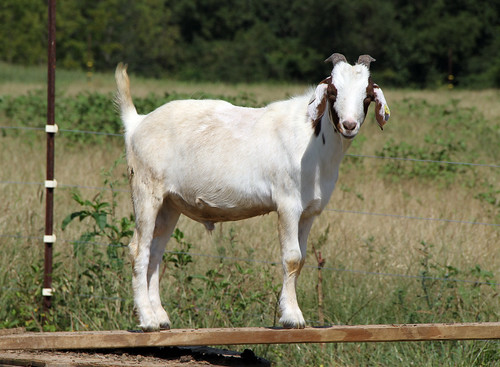Fourteen goats were dewormed on Thursday, August 30. Due to increasing fecal egg counts, worsening FAMACHA© scores, and loss of a goat (possibly to worms), FAMACHA© scores were re-checked 8 days after the previous check. The life cycle of the barber pole worm averages three weeks, but it can be much shorter when environmental conditions are ideal (warm + moist).
The average FAMACHA© score improved slightly from 8 days ago, averaging 2.56 ± 0.87 compared to 2.77 ± 0.95 on August 22. Any goat with a FAMACHA© score of 4 or 5 was dewormed. Goats with FAMACHA© scores of 3 and high fecal egg counts (on August 9 and 22) were dewormed. Goats whose FAMACHA© scores worsened were dewormed.
Goats dewormed on August 9 whose FAMACHA© scores failed to improve were dewormed again. Two scouring goats were dewormed since the last larvae ID showed that Trichostrongylus had increased to 15 percent of the worm load (scours are a symptom of Trichostrongylus).
The goats were dewormed orally with levamisole (Prohibit®, 3 ml/50 lbs.). Levamisole is usually the most effective dewormer for goats in the test. It also has a short withdrawal period, which is significant because some of the goats will be going to slaughter soon. Previously, goats requiring anthelmintic treatment were given oral moxidectin (Cydectin®, 2 ml/11 lbs.)
After having dewormed seven of the "pasture" goats in the pen vs. pasture study, only one was re-treated. The goats in the pen were not re-checked, as their egg counts and FAMACHA© scores were not of concern.
The last FAMACHA© scores will be recorded on Thursday, September 6. The last fecal sample will be collected on September 6. We should have the results of the last fecal analysis by Monday, September 10 (pm), after which time the data will be posted and final selection of the sale bucks will be made.
Download August 30 report
 |
| As of d-70, #21 (Garber) is the most resistant buck in the test. |
The average FAMACHA© score improved slightly from 8 days ago, averaging 2.56 ± 0.87 compared to 2.77 ± 0.95 on August 22. Any goat with a FAMACHA© score of 4 or 5 was dewormed. Goats with FAMACHA© scores of 3 and high fecal egg counts (on August 9 and 22) were dewormed. Goats whose FAMACHA© scores worsened were dewormed.
Goats dewormed on August 9 whose FAMACHA© scores failed to improve were dewormed again. Two scouring goats were dewormed since the last larvae ID showed that Trichostrongylus had increased to 15 percent of the worm load (scours are a symptom of Trichostrongylus).
The goats were dewormed orally with levamisole (Prohibit®, 3 ml/50 lbs.). Levamisole is usually the most effective dewormer for goats in the test. It also has a short withdrawal period, which is significant because some of the goats will be going to slaughter soon. Previously, goats requiring anthelmintic treatment were given oral moxidectin (Cydectin®, 2 ml/11 lbs.)
 |
| #24 (Majanczik) is meeting the Silver standards of performance. |
After having dewormed seven of the "pasture" goats in the pen vs. pasture study, only one was re-treated. The goats in the pen were not re-checked, as their egg counts and FAMACHA© scores were not of concern.
The last FAMACHA© scores will be recorded on Thursday, September 6. The last fecal sample will be collected on September 6. We should have the results of the last fecal analysis by Monday, September 10 (pm), after which time the data will be posted and final selection of the sale bucks will be made.
Download August 30 report











